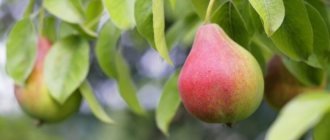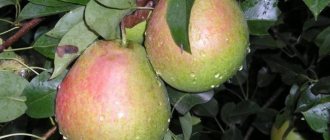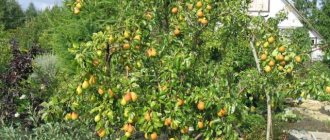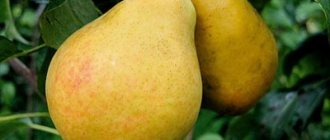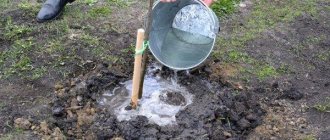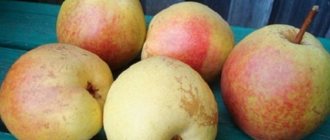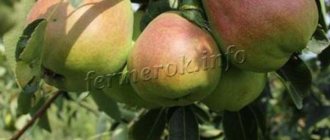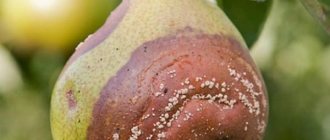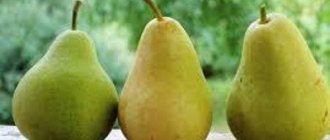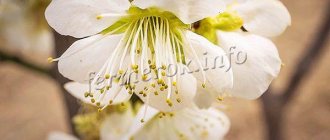Packham pear appeared on the Russian market relatively recently. This variety grows in South America and Australia. Many gardeners love the fruits for their excellent taste. The pulp is quite dense, but at the same time juicy, tastes sweet with a slight presence of sourness. After harvesting, Packham pears can be stored in a cool, well-ventilated place.
Description of the Packham pear variety
Ripe fruits of the Packham variety are oblong and irregular in shape, usually with small tubercles. The average weight of the fruit is 200 g. The peel is rough, rich green in color, with inclusions. At the moment of ripening, the color changes to yellow or cream.
Young seedlings look like pyramids with a spreading crown. The leaves are medium in size; there are a small number of them on the tree. As the fruits begin to ripen, the branches droop toward the ground, making the tree's shape irregular. When mature, the tree can grow up to 3 m in height. Flowering and fruiting are quite late; the tree can produce a harvest for about 80 years.
Important! Considering the description of the Packham pear, the seedling is not recommended to be planted on sandstones.
Harvesting and storage
Packham pear is a variety with good preservation and transportation. These hard, massive fruits can withstand long-term transportation and retain their appearance and nutritional quality.
Fruits are removed from the tree several days before ripeness so that the stalk is preserved and the place where it joins the fruit is not damaged. After this, the pears are sorted by size, ripeness and quality and placed in wooden or plastic boxes. In this case, they need to be laid out in layers of paper.
Boxes of pears are stored well in a dark, cool and dry room without sudden temperature changes for two or more months. The Packham variety, with all its wonderful qualities, has not gained popularity all over the world for nothing. These beautiful and tasty pears are a source of strength for humans and a source of care for gardeners.
Fruit characteristics
At the moment of ripening, the fruits become yellow, after which the pears become creamy. The pulp is juicy and sweet, crunchy when eaten.
Ripe fruits are low in calories, while pears contain a large amount of vitamins, micro- and macroelements. By eating Pakham pears, you can remove toxic components from the body. If you provide optimal storage conditions, the harvested crop will last in the basement for about 2 months.
Attention! If we consider the BJU (proteins, fats, carbohydrates) of Packham pears, then the percentage ratio is as follows: 0.85: 0.31: 8.52 g, and the nutritional value is 2.95%.
Characteristics of the variety
It is a recently developed variety. The base was Bartlett pear.
Ripening occurs in January and lasts until early autumn. Characteristic features of the variety are the presence of large, weighty fruits with tubercles and dots throughout the peel. The fruits of the Packham pear have their own uniqueness - a light, fragrant aroma combined with a sweet and sour taste.
Description of the tree
The seedling has a narrow pyramidal crown. The branches are strong. Leaves are medium sized. Over time, the branches bend under the weight of the fruit.
The advantage of the variety is regular fruitfulness. The first harvests appear approximately in the 4-5th year. And for 20-30 years the yield has been stable. On average, 30-40 tons of pears can be harvested from 1 hectare of land.
Pear grows in almost any soil except sandy and gravelly. The best are clay soils.
Description of the fruit
By the ripening phase, the fruits acquire a greenish-yellow color. But by the time of consumption, the color becomes creamy.
The surface is slightly rough. The cut flesh is light and juicy. It tastes sweet. It crunches slightly when bitten due to the presence of stony cells.
The fruits are greenish-yellow in color
According to the description, the fruits have:
- low calorie content - only 48 kcal/100 g;
- high percentage of carbohydrates - 10.9 g/100 g of fruit;
- low acidity;
- a large amount of fiber, which improves the functioning of the gastrointestinal tract;
- pectin, which lowers cholesterol levels;
- high content of fructose, phosphorus, iron, folic acid, potassium, which improves the functioning of the pancreas, heart and other muscles.
Consumption of ripe fruits of this variety promotes the rapid removal of heavy metals and toxic components from the body. The big advantage is that these pears can be stored for up to 2 months if the temperature conditions are met.
Due to the fact that the pulp is not watery, the fruits are easy to transport. They are not very prone to damage.
Pros and cons of the variety
When studying the benefits of the Pakham pear, it is necessary to highlight:
- high level of productivity;
- excellent taste;
- long shelf life of the crop.
According to gardeners, significant disadvantages are:
- rather low level of frost resistance;
- susceptibility to diseases and attacks by insect pests.
Before choosing a particular pear variety, it is recommended to study the available features.
Pear "Autumn Yakovleva"
The autumn ones taste no worse than others, but they can be stored a little longer. The fruits are harvested in early autumn.
Veles pear
The trees grow low with spreading branches. Fruiting from 6-7 years of cultivation. This variety of pears has a high tolerance to low temperatures; in winter it can withstand frosts down to -40 degrees. Plants are rarely affected by diseases and pests. Fruits ripen from the second half of August to the end of September.
Features of Veles:
- taste: pleasant, melting, sweetish with fresh sourness;
- pulp: creamy, semi-oily structure;
- peel: thin, smooth without spots, golden-green in color.
- weight – 130 g.
Stores well in the refrigerator for several months.
Veles pear
The pear grows tall with semi-spreading branches and shoots, and a pyramid-shaped crown. Harvest the first harvest after 5 years of cultivation. The quantity depends on the favorable climatic conditions. Responds well to soil moisture. Frost resistance is average. Resistant to powdery mildew and scab.
Features of Marble:
- taste: pleasant, delicate, sugary with sourness;
- pulp: whitish with large lumps, rich in juice;
- peel: thick with subcutaneous spots, yellowish-green in color with a red ruddy side.
- the fruit reaches 210 g and is round in shape.
Marble
Moskvichka pear
Trees of this species grow low with a dense crown. The harvest is harvested at the very beginning of autumn - September. The yellowed skin indicates ripeness. Stored at 0 degrees for up to three months.
Features of Moskvichka:
- taste: pleasant, delicate, sweet and sour, melting in the mouth;
- pulp: whitish, semi-oily structure, sugary and juicy, very aromatic;
- peel: yellowish-green with sparse blush and small subcutaneous dots;
- The fruits are of medium size, about 190 g, wide and uneven in shape.
To keep the crop longer, it is picked a couple of weeks before full ripening.
Moskvichka pear
Pears grow tall with spreading branches and shoots. Fruiting from the 5th year of growth. They survive frosts down to -20-30 degrees. Easily tolerate drought. They are often affected by scab. The culture gives a rich harvest of up to 30 kg per tree.
Features of Autumn Yakovlev:
- taste: pleasant, delicate sugar with fresh sourness;
- pulp: white, oily structure, not grainy, juicy, almost not aromatic, has a nutmeg flavor;
- peel: green with a small ruddy side and small subcutaneous dots of a dark color;
- medium-sized fruits up to 160 g, broadly classic in shape, uneven, with dents.
Pear variety Autumn Yakovleva
Red-sided variety
A late-ripening variety that grows up to 4 meters in height. Harvest at the end of September as soon as possible, as ripe fruits fall off quickly. Depending on conditions, they can be stored for up to 3 months.
Fruiting 6 years after planting. It survives severe frosts down to -50 degrees, tolerates drought, and is immune to scab and other fungal diseases.
Fruit Features:
- taste: tart, sweet and sour;
- pulp: whitish with small grains and an oily structure, juicy, aromatic and rich;
- peel: green with a red ruddy side, smooth, waxy and small subcutaneous dots of a dark color;
- The fruits are small, 160-190 g, in shape – even, smooth, typical shape.
Red-sided
The variety is grown in the central regions. The fruits ripen in September-October. Stores in the refrigerator for three months. Trees grow up to 4 m in height.
Features of Autumn Sweet:
- taste: sweet and sour;
- pulp: whitish, juicy, fragrant, melting in the mouth;
- peel: golden color with a red ruddy side, smooth, with small subcutaneous spots of dark color;
- round fruits weighing 160-240 g.
Withstands temperatures down to -30 degrees. Has high resistance to scab. From one tree you can harvest up to 35 kg of harvest. Fruits are stored for a long time.
Autumn sweet
To get a bountiful harvest in the autumn months, you need to wisely choose a good variety in the appropriate category. The varieties described below can easily be considered the best.
Planting and caring for Packham pear
To achieve high yields, it is necessary to provide the Pakham pear with proper care. To keep trees healthy, it is necessary to carry out preventive work to combat pests and diseases.
Landing rules
For planting, select seedlings up to 2 years old and up to 1.5 m high. The branches of a young tree must be flexible and the root system strong. Before planting the Pakham pear in open ground, you should keep the roots in a growth stimulator (for example, Kornevin or Heteroauxin) for 12 hours, which will allow the seedling to take root much better. After completing the work, the pear trees should be watered; each root requires about 20 liters of water.
Watering and fertilizing
Fertilizers are applied throughout the year:
- In spring, liquid fertilizers are used under the roots, in summer - preparations containing nitrogen;
- in July it is recommended to apply mineral and nitrogen fertilizers; if necessary, phosphorus can be added;
- in September they use nitrogen substances;
- before the onset of winter, potassium and superphosphates are added.
Seedlings recently planted in open ground are regularly watered. After watering, the soil is loosened, which helps prevent the appearance of an earthen crust. To ensure that water evaporates slowly, the ground around the pear tree is mulched, covered with manure or dry leaves.
Advice! If the Packham pear was planted in summer, then watering should be regular.
Trimming
The formation of young trees begins in the spring, before the onset of the growing season. To do this, weak side shoots are removed completely, as a result of which stronger branches unimpededly strengthen the base of the tree.
Mature pear trees are pruned 2 times throughout the year:
- in early spring;
- late autumn, when the movement of juices slows down. In this case, it is necessary to remove old branches and thin out the crown.
Advice! To restore the yield level of the Packham pear, it is recommended to rejuvenate the tree once every 10 years - remove all branches, leaving a few of the strongest ones.
Whitewash
The Packham pear needs whitewashing so that during the growth process the trunk is not susceptible to frostbite and sunburn. Otherwise, cracks appear on the tree bark, into which pests and fungal spores penetrate and the process of infection of the fruit tree begins. You can purchase a ready-made solution in a specialized store or prepare it yourself.
Preparing for winter
The root system of the Packham pear needs shelter for the winter. The work algorithm looks like this:
- The trunk is wrapped with paper, cardboard or straw.
- Existing weeds are removed around the planting hole.
- Before sending the tree to winter, it is watered abundantly.
- Fertilizers can be added if necessary.
In order for the pear tree to better tolerate low temperatures, it is necessary to pre-treat the plant with an Ecobin or Zircon solution.
Features of growing a plant
Pakham is a heat-loving plant. It is recommended to plant it in places protected from the wind. Pear loves a lot of sunlight and does not tolerate swampy soil. Excess moisture can cause root rot.
Choosing a place and time for landing
Pakham grows on any soil, but prefers clay soil and black soil. It can produce crops on sandy soil if it is fertilized with organic matter and minerals. Pear does not like too wet soil. It is not advisable to plant it in the shade of other trees. Packham is not prone to self-pollination. It is recommended to plant it near other varieties of pears.
Pakham can be planted in early spring or late autumn. Spring planting is preferable for regions with warm climates. Seedlings are buried in the ground until the buds open. In autumn, trees are planted before frost sets in so that they have time to adapt to the new environment.
Preparing the planting hole
Before planting, you need to dig a shallow hole - up to 1 meter deep. It should remain open for some time. The excavated soil is mixed with humus, sand and mineral fertilizers (potassium and superphosphate).
Preparation of seedlings
It is better to buy planting material from nurseries. Seedlings should be no more than two years old. The height of the plant for planting is about 1.5 meters. The tree must have flexible branches and a strong root system. Before planting, the seedling is placed in a Heteroauxin solution for 12 hours. It stimulates the growth of the root system.
Planting scheme
Part of the excavated and fertilized soil is poured back into the hole. Then the seedling is immersed in it and sprinkled with soil up to the root collar. After planting, two buckets of settled water are poured under the root.
Pollination
When growing pears, take into account that there are varieties capable of self-pollination, but most pear trees, including the Packham variety, are self-sterile. If the pollination process occurs naturally, then there will be no result and the fruits will not set. Forest Beauty, Olivier de Serre, and Clapp's Favorite are used as pollinators for this variety.
If necessary, you can pollinate fruit trees yourself. To do this, purchase a special preparation in the store and, according to the attached instructions, pollinate the Packham pear.
Origin story
The Williams variety appeared in the 18th century, its homeland is England. It got its name in honor of the popularizer of this variety, Richard Williams. And the author of the Williams Packham pear variety (popularly known as the Argentine pear) since 1890 is the breeder Charles Packham from Australia, from where, in particular, it is brought. It bears fruit in summer, autumn, winter and early spring - from January to September.
Important! In the southern hemisphere, January is the peak of summer.
It differs from other subspecies of its variety not only in taste characteristics, but also in the place where it grows: the Packham pear is found in Argentinean, Australian, South African and Chilean orchards. It does not grow in Russia and the CIS countries, although attempts are being made to grow spruce or ordinary mountain ash on a rootstock. However, it is most likely to be found in a store.
Pear Packham
Productivity
Before you start planting planting material, it is recommended to first study the advantages, disadvantages and features of the Packham pear variety. As a rule, planting should be done in groups; trees should not be planted individually, as there is a high probability that the seedling will die.
As a rule, fruiting is abundant. You can start harvesting the finished crop 4 years after the tree was planted in open ground. The period of active fruiting occurs in the seventh year of the tree’s life. As experienced gardeners have noticed, from each specimen you can collect from 80 to 150 kg of ripe fruits.
Description and varietal characteristics
The pear called “Pakham” produces fairly large, voluminous, green fruits with an unevenly expressed rough surface. The pulp of the ripe fruit is unusually aromatic, sweet, juicy and crispy. In the phase of consumer ripeness, the cut fruit has a light cream color and a smooth structure. The taste is excellent. The taste is very delicate, sour-sweet.
The shape of the "Pakham" fruits is larger and somewhat wider than the fruits of the "Bartlett" variety, and also ripen earlier. This is the main variety grown for export. Currently, about 33% of the volume of pears exported from Chile comes from the Pakham variety, which is characterized by very high productivity rates. This variety of pear is exported to our country not only from Chile, but also from Argentina and South Africa.
Calorie content of Packham pear
The calorie content of Packham pear is 42 kcal per 100 grams; in addition, it contains:
- proteins – 0.7 g;
- fats – 0.2 g;
- carbohydrates – 10.9 g;
- acidity is moderate.
The fruits contain useful substances, but they can negatively affect the gastrointestinal tract, so it is not recommended:
- wash down fruit with water;
- eat on an empty stomach;
- combine with meat and curd products.
If you follow these recommendations, then Packham pears will bring significant benefits to the body.
Attention! The stronger the aroma of the pear, the more beneficial substances it contains.
Description of the pear Elegant Efimova
The height of the tree reaches 4-5.5 m. Its crown is of a pyramidal type. The branches extend from the trunk at sharp angles. They have an average number of leaves, which look like large ovals. The shoots are painted in dark red tones. The bark of the variety is smooth, gray in color. The buds have an elongated shape and a smooth surface.
Fruit characteristics:
- the average fruit weight ranges from 90-120 g, but some gardeners managed to obtain specimens weighing up to 180 g;
- subcutaneous inclusions are visible under the smooth skin;
- fruits are removed from the tree when they are colored green and yellow;
- a fully ripe pear has a burgundy color;
- large seeds;
- the pulp is juicy and tender, white in cross section;
- the taste is sweet, with a small amount of acid.
Note: It is recommended to remove unripe fruit from the tree. In this form, they are stored longer (from 15 days to a month) and can be transported over long distances. If the fruits are left to ripen on the branches, their taste deteriorates and they themselves disintegrate.
This pear hybrid has a yield of up to 40 kg per tree. Fruiting begins 6-8 years after planting the seedlings.
In sunny summers, the harvest is carried out in the last days of August, and in cloudy weather it is postponed until September. The description of the smart Efimova pear in the agricultural catalog states that the variety has good frost resistance. In winter, an adult tree does not need to be wrapped, but young seedlings are recommended to be insulated with special material (reeds) and protected from small rodents.
This pear hybrid develops well in poor soils, which makes it possible to grow it almost everywhere. The main pollinator for this variety is the bee, but it is advisable to place pear hybrids of a different type next to it for cross-fertilization.
Note: the plant is not susceptible to scab, bacterial infection, cancer, or fruit rot. It is resistant to gall mites and other garden parasites.
Diseases and pests
Most often, the Packham pear is affected by rot, fungus and insects. By carrying out preventive measures and timely treatment, you can maintain the health of the tree. Among the common problems gardeners note are the following:
- scab – the fruits of an infected tree begin to crack and become woody;
- rot is a disease brought in by birds, resulting in growths appearing on the fruit;
- black cancer - the tree itself becomes infected, the bark begins to deform.
To prevent diseases, you can use traditional methods or insecticides.
Pests and diseases
The Pakham variety is susceptible to scab. This is a fungal disease that is diagnosed by brown spots on leaves and fruits. Gradually, the damage increases, the fruits become hard and crack. Bordeaux mixture helps fight scab.
The pear suffers from attack by pests: leaf rollers, aphids, and gall mites. To get rid of insects, use the preparations Agravertin or Iskra. Treatments are carried out before the crop ripens. For prevention, fallen leaves are removed annually from under the tree, and the trunk is cleaned and whitewashed.
Reviews of Packham pear
Tatyana Semenova, 49 years old, Moscow
I first tried Packham pears from friends, really liked the taste, and decided to try growing them myself. The appearance is quite unusual - small tubercles, “freckles”, the fruit is quite heavy, rich yellow in color. The productivity was high, as it provided the tree with high-quality care, watered it in a timely manner, and applied fertilizers. If you let the pears sit for a while after harvesting, they will be much juicier.
Ivan Streltsov, 62 years old, Ulyanovsk
I have been growing pears for quite some time. Since the yield is always high, I sell most of it, and use the rest for personal purposes. The pulp is pleasant to the taste, firm, crispy when bitten, juicy, sweet. Due to the content of a large amount of vitamins, this pear variety is popular among consumers. Unfortunately, Pakham gets sick more often than all other varieties; if you treat the trees in a timely manner, infections can be avoided.
Care
Due to its late ripening, Packham does not tolerate temperature changes well, unlike summer pear varieties. After harvesting, it is necessary to carefully check the fruits for defects.
Storage should be carried out in dark, cool, well-ventilated areas, with a temperature of 0-2 °C. Cellars, rooms without heating, warehouses for vegetables or fruits are suitable for this. It is not recommended to store with products that have a strong odor.
Winter varieties require high-quality insulation of the root system. The following activities are additionally carried out for young trees:
- the trunks are wrapped with film, cardboard, straw, or burdock and sunflower leaves;
- do not allow the surrounding circles to become overgrown with weeds;
- careful and regular watering is necessary;
- autumn feeding is carried out with potassium and phosphorus fertilizers;
- trunks need whitewashing;
- mulch with peat or sawdust in a layer of up to 25 cm.
Before the onset of cold weather, plants should be treated with Ecoberin or Zircon solutions. This increases resistance to adverse weather conditions.
Watering
After planting in the ground, seedlings must be provided with moisture. After irrigation, the soil is carefully loosened to avoid the appearance of a crust. To prevent the water from evaporating quickly, the watering area is sprinkled with manure and dry leaves and grass.
Fertilizer
Feeding is carried out throughout the year, except winter. Main stages:
- With the arrival of spring, liquid or solid fertilizers are applied under the roots. By summer, feed with preparations containing nitrogen. Since June, it has been customary to apply nitrogen-containing preparations by spraying.
- In July, mineral and nitrogen fertilizers are used. It is possible to add phosphorus and potassium.
- September is the last date for fertilizing with nitrogen substances. It is necessary to stimulate growth. Before the start of winter, it is recommended to feed potassium and superphosphate into the tree trunk circle.
Winter varieties require increased protection on cold days. If planting was done in the summer, then watering should be done regularly. Because Since such trees are not yet sufficiently rooted, their tree trunk areas require frequent loosening of the soil, weeding and fertilizing.
Packham pear varieties need quality care
Whitewash
Almost all the trees in the garden are whitewashed, as the spring sun burns the plant that has not yet woken up after winter. But tender Packham pears especially require this procedure: if they get sunburn, the bark may crack, which provides shelter for pests.
Whitewashing is done in spring and autumn with a purchased solution or a self-prepared composition.
Important! Before whitewashing, the trunk must be cleaned with a metal brush to remove growths, lichen, and dead pieces of bark.
To make the mixture you need the following ingredients:
- water - 10 l;
- lime - 2.5 kg;
- copper sulfate - 0.5 kg;
- PVA glue (or carpentry glue) - 0.5 l.
All components are thoroughly mixed and left for 2-3 hours. After this, the composition is applied to the trunk with a thick brush or roller up to the first branch.
Pruning and rejuvenation
The crown of young plants should be formed in the spring - before the growing season. All side shoots need to be pruned, giving the main, strongest branches the opportunity to strengthen. They are left from 5 to 7 pieces.
Pear for diet
There is even a pear diet. The secret is very simple - pear for breakfast and lunch. Of course, you shouldn’t forget about other products. A pear breakfast can be supplemented with crispbread or black bread, a small portion of buckwheat or rice porridge. For lunch, add fresh vegetables or herbs, cheese, eggs, and low-fat dairy products. For dinner, eat something light - low-fat cottage cheese or a glass of milk. This diet allows unsweetened green tea, as well as meat (chicken breast, lean beef). Very important: meat can be eaten after the pear after three hours. Do not forget!
Description of the Ussuri pear
Apricot kernels: benefits, harm, reviews and photos
The variety is not registered in the State Register of the country, but the originator since 1989 has been the Far Eastern State Agrarian University. The fruit tree is zoned in all regions and gives excellent growth and yield indicators. The crown of the Ussuri pear has a clear spherical shape, although the young tree needs to be pruned and shaped. The height of an adult tree reaches 10-15 m. Healthy bark has a black color and a rough surface.
The harvest from the Ussuri pear variety is sweet in taste, with a slight sourness in the aftertaste. The skin of the fruit is crispy and slightly tough. The pulp is juicy, grainy, snow-white in color. The shape of the fruit is spherical, sometimes slightly elongated. Ripe pears exude a pleasant sweetish aroma, have a natural waxy coating and a greenish color with a red side. Tasting rating of fruits on a five-point scale – 4.3 points.
The pear grows with flexible yellowish-brown shoots up to 3-4 m long. The foliage is dark green with a glossy tint, and during the growing season it becomes covered with sticky juice. A distinctive feature from other varieties is that the leaf has an elongated, heart-shaped shape with small notches along the edges near the base. The reverse side of the foliage is matte in color with pronounced veining. When autumn comes, the crown changes color from green to brown and yellow. The life cycle of a pear lasts up to 75 years, in the wild from 150 to 300 years.
Beneficial features
Since ancient times, the medicinal properties of pears have been highly valued all over the world, because they are endowed with vitamins and a wide variety of beneficial microelements. In particular, pear contains a considerable amount of fiber, which normalizes the functioning of the gastrointestinal tract, accelerates metabolism in the body and helps reduce excess weight.
- Pears contain many vitamins, including A, B1, B2, C, beta-carotene and folic acid.
- The fruits of pakham pears have a beneficial effect on the functioning of the thyroid gland, as a result of which the body is able to easily absorb iron and remove excess water.
- The pulp of the fruit contains pectin, which is often called “the body’s orderly.” It helps normalize blood circulation, reduces cholesterol levels and stabilizes metabolism.
- Eating ripe pears helps remove toxic substances and heavy metals from the human body, which is an extremely useful property in the current polluted environment.
- The nutritional properties of the fruit are characterized by low acidity and a high amount of carbohydrates, which gives the pear a balanced taste and the body energy to work.
- Due to the presence of fructose, pears can be taken by people who have problems with the pancreas.
- In addition to all of the above, they strengthen the human immune system, promote the formation of hemoglobin, and in general are an indispensable component of a healthy diet.
Storage methods and periods
- the variety and its characteristics make their own adjustments to the method of storing fruits. For example, if it is necessary to preserve fresh pears for a long time, then for this it is necessary to use exclusively winter varieties - they are placed in a cool room while they are not yet ripe, and they ripen already during storage.
- Pakham pears are a late-autumn variety and are little susceptible to temperature changes. In addition, their uniqueness lies in the fact that for a more refined taste and juicy fruits, it is necessary to give the pears time to rest, since they exhibit their taste properties only after a certain period of time after picking.
- Before stacking fruits, they must be checked for damage in order to avoid rot. The ideal place to store fruits is a dark and cool room, with a temperature of zero to two degrees Celsius. Such a room may well be a cellar, basement or unheated room.
- in this environment, pears can lie for up to three months and will not lose their appearance and taste; as a result, the fruits will be fully preserved until the end of autumn and will delight you with their taste and nutritional properties.
Educational facts
And in conclusion, here are seven of the most interesting facts about these wonderful fruits. Get ready, some of them may surprise and amaze:
- In total, there are about three thousand varieties of pears in the world.
- Rose and pear are close sisters. Both plants belong to the same order - Rosaceae. In addition to them, it also includes figs, raspberries and apple trees. In total, the order amounts to about two thousand plants.
- Pakham pears contain useful microelements such as phosphorus and calcium, which can reliably strengthen tooth enamel.
- The famous philosopher "Homer" called the pear "food of the gods." And not without reason, because today it is one of the most popular fruits
- Before the advent of tobacco in Europe, pear leaves were most often smoked.
- One fruit contains a fifth of the daily fiber intake and a tenth of vitamin C.
- Recently, gardeners have learned to graft pear trees with rowan trees. As a result, pears grow well on it, but the fruits become less juicy and have the astringency characteristic of rowan berries.
As practice shows, the variety developed by Charles Packham has become so popular for a reason. The incomparable aroma of the fruit and a large amount of vitamins have made pakham pear an indispensable element in the diet of an active and healthy person.
What care does the Packham variety require?
The health of the tree depends on proper care.
Optimal growing conditions
The Packham pear variety should be planted in the south of Russia in the spring, when the threat of frost has subsided. In the Krasnodar, Stavropol Territories and Crimea the weather is unstable in March, but in April the seedlings take root and grow well.
Watering and fertilizing
The Packham variety is very fond of mineral fertilizers. They are added at least three times. In the spring, nitrogen fertilizers and cow manure are used, preferably rotted over the winter. Suitable fertilizers for pears are “Master 20.20.20”, “Fertika Universal-2”, Standart NPK, “Master-Agro”.
See also
Description of drugs and folk remedies, how to treat a pear to get rid of aphids
Read
In autumn, nitrogen fertilizers are replaced with potassium-phosphorus fertilizers (potassium salt, potassium sulfate, potassium sulfate). Bone meal and phosphorous meal will help the trees survive the winter better.
After the rain, the ground is loosened so that a crust does not form and the roots do not rot.
Pruning and crown formation
Pruning is a preventative measure to combat fungal diseases. It is carried out in the spring before the buds open. Using pruners, remove dry, damaged and old branches. The stumps are not left, but the cut areas are covered with garden varnish.
Whitewash
Whitewashing is necessary to protect the bark from the negative effects of sunlight. You can whitewash the trunk both in early spring and in summer. It is not recommended to do this in the fall, because the whitewash will be washed off over the winter.
Diseases and pests: preventive treatments
Most often, the Packham pear is subject to the following misfortunes:
- Scab. First, brown spots appear on the fruits, which gradually harden. Over time, they crack, deteriorating the appearance of the fruit. They lose their presentation.
- Fruit rot. The fruit rots right on the branch, becoming covered on top with round light growths of fungal spores. The fruit becomes inedible and the spores are transferred to neighboring trees.
- Black cancer. The spores infect the bark and skeletal branches, cracks form on them, with brown spots visible along the edges. Gradually, the bark breaks, the trunk becomes bare, and the tree dies.
Control measures include removing affected fruits and spraying trees with Horus, Abiga-Peak, and Bordeaux mixture. Mineral fertilizers are applied to the tree trunk circle to strengthen the tree's immunity.
Preparing for winter
In the autumn, when the tree sheds its leaves, the tree trunk circle is dug up and potassium-phosphorus fertilizers are applied (superphosphate, Kalimag, potassium chloride, potassium sulfate, nitroammophosphate, potassium monophosphate, bone meal).
Before completing gardening and field work, the soil around the pear is dug up with the addition of ash and mulched. Spruce branches and spunbond are placed on top for insulation.
